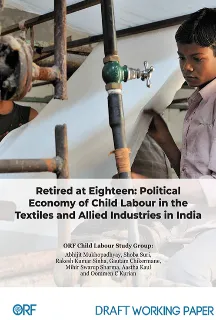This report analyses the use of child labour[1] in the textiles and allied industries in India, and the drivers that lead to its prevalence. India, home to one-fifth of the world’s children, has the highest rates of child labour: an estimated 33 million children under the age of 18 are engaged in work in various sectors across the country, from domestic service and agriculture, to textiles and mining.
The textiles and allied industries are the second largest employers in India after agriculture, with 40 million direct and 60 million indirect employees. As a traditionally labour-intensive industry—where flexible and low-cost labour has driven growth and pushed India’s global competitiveness in the sector—the textiles sector is enabled by the massive use of child labour. The continuing practice of child labour has the potential to jeopardise India’s push for incentivising foreign investments into the sector and integrating into global supply chains.
This report seeks to address key facets of the issue and provide holistic policy solutions. It is divided into three sections: Chapter 1 reviews key literature about child labour in India, particularly its causes and impacts. The second chapter provides an analysis of child labour in India within the garment and textile industry, using data from 88 sub-state regions (a collection of districts) covered by the National Sample Survey (NSS) of 2011-2012. The final chapter tests the hypothesis that labour costs are the main drivers of global competitiveness in the textiles and allied industries. This is done through an analysis of NSSO unit-level data from the Enterprises Survey 2015-16, of ten sub-state regions.[a]
▪ The Ministry of Textiles should reinvigorate and renew the cooperative movement among micro and family-level enterprises, helping the sector reap the benefits of economies of scale.
▪ District administrations in areas of high child labour incidence should be sensitised to the issues and catalysed to incentivise parents to send their children to schools.
▪ The Ministry of Labour and Employment must explore new ways of implementing anti-child labour laws at the district level. The Ministry of Human Resource Development should expand the reach of scholarships to pull children to schools.
▪ The Ministry of Finance and the Reserve Bank of India need to deliver a closer alignment of the Pradhan Mantri MUDRA[2] Yojana with micro enterprises, and ensure that entrepreneurs are able to avail of loans under the scheme.
▪ The Ministry of Human Resource Development should expand the scope of the Right to Education to include higher secondary levels (up to Class 12).
▪ The Ministry of Skill Development and Entrepreneurship should target skills training to children in areas with high child-labour concentration so that they can transition to better-paying opportunities.
Introduction: Child Labour as a Roadblock to India’s Human Capital Accumulation
Child labour deprives the young of their rights and dignity, and robs them of the opportunity to fulfil their full potential. Of the estimated 152 million children under the age of 18 engaged in labour across the world, 73 million are engaged in hazardous work.[3] They can be found in a wide array of industries – from domestic service and agriculture, to more hazardous sectors such as mining. India, home to one-fifth of the world’s children, has among the highest incidence of child labour: some estimates peg the number of child labourers at over 33 million.[4] While the number has declined over the years, child labour in India remains in a massive scale and represents the insidious side of not only domestic, but global supply chains.
What compounds India’s child labour problem is that a large part of it is considered “legal”.[5] Current definitions of child labour leave children between 14 to 18 in a limbo—they are considered too young to be adults but old enough to be out of school and in low-paying, low-productivity jobs.[6] These children will remain underemployed and unemployed in their adult life, until they are eventually replaced by younger, cheaper hands; by then, they would not have nurtured any skills to move to other gainful employment. A vicious cycle is perpetuated, whereby fragmented welfare schemes subsidise them for the rest of their lives.
Much of child labour and trafficking is invisible, but the National Crime Records Bureau (NCRB) records cases filed across the country under the Child Labour (Prohibition & Regulation) Act, 1986. An analysis of child labour cases filed in India across the last five years for which data are available shows that the number of cases has gone up from 147 in 2014 to 464 in 2018. The number of cases for which trials got completed also improved over time—from just 10 in 2014 to 78 in 2018. Convictions were made in just three cases in 2014 but the number was 34 in 2018, showing an improvement. The conviction rate, which was 30 percent in 2014, increased to 43.6 percent in 2018.
Figure 1. Child Labour Cases in India (2014-18)

As one of the youngest nations in the world with two-thirds of its population below 35, India still has time to reap its demographic dividend. However, there remains a high proportion of children dropping out of school at 14 years—when the protection offered by the Child Labour (Prohibition and Regulation) Amendment Act and the Right of Children to Free and Compulsory Education Act ends. This creates a perverse incentive in the system by creating a vulnerable group of children who could easily be absorbed into the workforce.[7] The expansion of the Right to Education Act to include compulsory and quality secondary education as suggested in the draft National Education Policy 2019 will result, hopefully by implication, in a revision of the definition of child labour.
Child Labour in India’s textiles and allied industries
Child labour in India is widely prevalent in the textiles and garments industry. To begin with, India is one of the world’s largest producers of textiles, with the industry generating two percent of India’s GDP in 2014-2015.[8] The textiles industry is diverse, ranging from small household enterprises to large garment plants, and has employees in both the organised and unorganised sector. In fact, it is the second largest employer in the country after agriculture, with 40 million direct employees and another 60 million indirect employees.[9] It is a traditionally labour-intensive industry, where flexible and low-cost labour has remained a critical factor in maintaining India’s global competitiveness and subsequent viability.
The use of child labour is seen as a method of lowering labour costs. As this report has highlighted, children are employed in all stages of the process – from cotton-picking, to finishing the product by embellishment and embroidery. Indeed, children under 14 account for almost 25 percent of the total workforce in India’s cottonseed farms.[10] Furthermore, as a considerable proportion of child labour in textiles and allied industries are found to be in household-based enterprises—where regulation and social responsibility is not a major concern—minority and disadvantaged groups are disproportionately affected. Studies have found that child labour is most prevalent in the rural parts of the country and is highest amongst girls, the Muslim community, Scheduled Caste/Scheduled Tribes and Other Backward Classes.[11] As this study shows, the proportion is even more highly skewed in the textiles and allied industries, where eight of every 10 child labourers are Muslims.
The data presented in this report breaks the mould of past narratives, in the process highlighting the need for a re-mapping of child labour in India. For example, this study found that the general category population of child labourers in the textiles and allied industries is a considerably high 58 percent, which is in stark contrast to the overall economy where they constitute a much lower 23 percent.
Child Labour and Human Capital
The practice of child labour has significant implications for human capital development and great opportunity costs for India’s ability to develop its human resources. While in the short term it may seem that child labour increases household incomes, the practice perpetuates the cycle of poverty through reduced human capital accumulation. As the literature shows, child labour has serious physical and psychological health impacts caused by long hours of work and unsafe working conditions. Children employed in the zari (embroidery) sector, for example, suffer from damaged eyesight and hands by the time they reach adolescence (14-18) from working long hours in rooms that do not have proper lighting.[12]
The health issues are compounded by the lack of education and skills resulting from being out of school. While the figures vary, a UNICEF study on child labour in home-based garment work found that about 71 percent children aged 11 to 14 years were either out of school or working part-time after school.[13] Indeed, the use of children for their economic output in their most vulnerable stages have immense implications. On a micro level, low levels of health and education will lead to poor-paying jobs in adulthood, which will further increase the chances of their children to be forced into child labour, thereby perpetuating the cycle of poverty.[14] On a macro level, the skills gap created by uneducated children will add to the already high rates of youth unemployment and leave them at the mercy of the welfare system, in turn slowing down India’s long-term growth.
Eliminating Child Labour in India: Legal Challenges
If India is to achieve the Sustainable Development Goal (SDG) 8, which calls for the promotion of “sustained, inclusive and sustainable economic growth, full and productive employment and decent work for all”,[15] the country must prioritise the abolition of child labour.
To be sure, India has already made significant strides in the fight against child labour. It is signatory to a wide gamut of international conventions and treaties that aim to cease the practice of child labour. Most recently, in 2017, the country signed two ILO conventions concerning the ‘Prohibition and Immediate Action for the Elimination of the Worst Forms of Child Labour’ and the ‘Minimum Age for Admission to Employment’.[16] With India’s ratification, almost all of the world’s children are covered by both these conventions, enhancing global efforts on abolishing child labour.[17]
However, international treaties and conventions must be translated into domestic legislation, and India’s current legislative architecture around child labour leaves a lot to be desired. To its credit, India has passed several laws throughout the last century prohibiting child labour, the most notable of which is the Child Labour (Prohibition and Regulation) Act, 1986. The law, albeit controversial, contained a particular set of occupations and processes where children under the age of 15 were prohibited from being employed.[18]
The 2016 amendment to the Act expanded the ambit of the legislation to adolescents (15-18). At the same time, however, the amendment created loopholes that have inevitably ignored the realities of sectors engaging in child labour, especially the garments industry. The amendment prohibits all forms of labour for children under the age of 15 except in the case of family businesses and home-based enterprises. It further prohibits hazardous adolescent labour in only three sectors – mining, explosives, and those occupations mentioned in the Factory Act.[19] There are several caveats to this amendment – the first and most important is that the law ignores the realities of which it seeks to legislate upon. As highlighted above, the highest incidence of child labour in the garments industry is found in home-based enterprises, and estimates suggest that 10 percent of hazardous adolescent labour occurs in family enterprises.[20] Second, it assumes that all work is bad work; the presumption is unfounded. Age-appropriate employment in controlled, safe environments that does not interfere with schooling, can provide skills development and be regarded as a normal part of childhood. Third, the ambiguous nature of the legislation not only makes implementation and enforcement extremely difficult, but demonstrates India’s legal inefficiencies in addressing the root of the problem.
Furthermore, as argued earlier, eliminating child labour is not a panacea and efforts must be coupled with a specific focus on human capital development. India’s legislative framework has focused predominantly on the nexus between education and child labour and has neglected to address the concomitant health issues. The Ayushman Bharat Pradhan Mantri Jan Arogya Yojna (PMJAY) scheme should bring about changes going forward and be incorporated within the child labour legal framework ensuring coverage and health protection to high-burden areas in particular.
While the new draft National Education Policy has committed to free and compulsory quality secondary education to adolescents, the implementation strategy, yet again, fails to anchor on reality. Access to capital remains a key barrier to eradicating child labour and even within a supposedly ‘free’ education system, ‘fixed private costs’ such as transport and study materials cause many families to pull their children out of school.[21] Furthermore, as highlighted in this report, direct cash transfers to working families are more effective in eradicating child labour than incentives such as mid-day meals. A similar trend can be found in a study of the Mahatma Gandhi National Rural Employment Guarantee Scheme (MGNREGS), which found cases of adolescents working at worksites to supplement family income.[22]
The legislative inefficiencies highlighted in the preceding paragraphs have made it clear that it is necessary to visit child labour from an economic lens as opposed to viewing it simply as a human rights issue. Eliminating child labour while developing avenues for quality education and health access, and increasing access to capital, can lead to inclusive growth and boost the economic output of the largest youth population in the world.
Child Labour: Creating Cooperatives
Despite the government’s shortcomings, its intervention remains key in eradicating child labour. In the context of the garments industry, India has already granted sweeping incentives and investments and the textiles and garments industries currently have 100-percent FDI.[23] Furthermore, the Make in India Programme has several initiatives to develop state-of-the-art infrastructure and upgrade current machinery; create environment-friendly processing units; harness skill development of textile weavers; and assist textile exporters in exporting to specific markets.[24] However, these initiatives, again, often fail to address the realities around child labour in India, and its continued practice can jeopardise investments and the Make in India Programme itself, due to the stigma facing employers of child labour amongst global businesses.
To this end, as highlighted in this report, cooperatives can be an effective mediator between governments and enterprises in creating grassroots campaigns and initiatives to eliminate child labour. Cooperatives are member-owned, member-led organisations formed by businesses and local enterprises who create initiatives towards the eradication of child labour. This report has highlighted several such cooperatives that have been effective such as the partnership between European fashion retailer MIGROS and exporters from Tirupur, the hub of knitwear in India, which provides full-day school and meals to children of employees so they do not engage in informal unemployment. RUGMARK is another cooperative which works with loom owners and carpet exporters to curb the employment of children under 14 years. A cooperative approach can improve financing, enhance profitability, create awareness and tackle poverty by bringing down the costs of production. However, as highlighted by the ILO, there is still a dearth of data on the effectiveness of these cooperatives, as many do not have monitoring and evaluation reports.[25] Better reporting practices will be key in filling this information gap and facilitate efforts by businesses and enterprises.
Ethical Trading: Harnessing India’s Competitive Advantage
As argued earlier, the race to the bottom has placed a special emphasis on finding cheap production costs for the textiles industry to thrive. Indeed, the phenomenon of ‘fast fashion’[26] has a deteriorating effect on working conditions and gives rise to a situation where children are employed and made to work in dangerous and unhealthy working environments.
Ultimately, this is the result of a gap between the objective of global supply chains to integrate countries like India into itself, and the operational level with problematic or non-existent micro-compliance. The power ultimately vests in global businesses to create transparent and traceable supply chains to curb the use of child labour. Various studies have found that the majority of the global child labour population in the garment sector caters to the demands of consumers in Europe and the United States (US). With increasing awareness of the abuse faced by labourers, large brands are increasingly positioning themselves in the arena of “fair trade”, engaging only with ethical suppliers.
India has a significant interest in branding itself as an ethical trader – it does not have the comparative advantage of wages, and cannot compete with countries like Ethiopia and Bangladesh in this aspect. Engaging in fair trade practices, where workers are given decent wages and work in safe and dignified conditions, will not only improve the quality of the fabric, but deviate from India’s current position as having a large population of child labourers.
As a corollary, the global demand for man-made fibre (MMF) and fabrics have steadily increased; here, India has comparative advantage. Coupled with doubling-down on its position as an ethical trader, investment in technological innovations related to synthetic fibre and fabrics,[27] can ensure that India maintains its viability as a leading player in the garments industry.
To conclude, a preliminary examination of child labour in India highlights the perverse nature in which child labour in the garments sector is subsidising India’s inefficiencies—from perpetuating the insidious inequities that run across the country, hindering human capital development, and underscoring its legal inadequacies. The following chapters will further examine the key facets of child labour in India and delve deeper into the causes and impacts of its prevalence, the implications on human capital, and the nexus between labour costs and global competitiveness in the textiles and allied industries.
Read the full report here.
Endnotes
[a] This study was supported by the Children’s Investment Fund Foundation, India.
[1] As defined by the International Labour Organization (ILO), child labour is work that deprives children of their childhood, their potential and their dignity, and obstructs their physical and mental development.
[2] Micro Units Development and Refinance Agency.
[3] ILO 2020. ILO Child Labour Convention achieves universal ratification.
[4] Jacobs, John, and Reeva Misra, “Child Labor: The Inconvenient Truth Behind India’s Growth Story“, The Washington Post, 2017.
[5] Nayyar, Dhiraj, “What India can Do for Malala”, Bloomberg, 10 October 2014.
[6] Ibid
[7] Ibid
[8] Make in India, “Policy Ecosystem For India’s Textile Sector – Make In India”, 2017.
[9] Ibid.
[10] India Committee of the Netherlands, “Cotton’s forgotten children child labour and below minimum wages in hybrid cottonseed production in India”, 2015.
[11] Sadana, Nidhi, “Dalit Childrenin RurAL India: Issues Related to Exclusion and Deprivation”, Indian Institute of Dalit Studies, 2016.
[12] Agrawal, Sugandha, and Priyanka Ribhu, “Brief Guide To Garment Manufacturing And Child Labour In Garment Sector In India“, Global March, 2001.
[13] Mehrotra, Santosh, and Mario Biggeri, “The subterranean child labour force: subcontracted home based manufacturing in Asia“. 2017.
[14] Galli, R, “The Economic Impact Of Child Labour”, International Labour Organization, 2001
[15] United Nations, “Goal 8: Promote Sustained, Inclusive And Sustainable Economic Growth, Full And Productive Employment And Decent Work For All — SDG Indicators“. Unstats.Un.Org, 2016.
[16] International Labour Organisation, “India Ratifies Both Fundamental ILO Conventions On Child Labour“, 2017.
[17] Ibid.
[18] Clc.Gov.In, “Child Labour (Prohibition And Regulation) Act, 1986“, 2019.
[19] Labour.Gov.In, “The Child Labour (Prohibition And Regulation) Amendment Act, 2016“, 2016.
[20] Save the Children, “Statistics Of Child Labour In India State Wise“, 2016.
[21] Sarkar, Jayanta, and Dipanwita Sarkar, “Why does Child Labor Persist with Declining Poverty?”, Economic Inquiry 54 (1): 139-158., 2015, doi:10.1111/ecin.12234.
[22] International Labour Organization, “Impact of Mahatma Gandhi National Rural Employment Guarantee Scheme on child labour”, 2013
[23] Make in India, “Policy Ecosystem For India’s Textile Sector – Make In India”, 2017.
[24] Ibid.
[25] International Labour Organization, “Cooperating Out Of Child Labour – Harnessing The Untapped Potential Of Cooperatives And The Cooperative Movement To Eliminate Child Labour“, 2009
[26] Moulds, Josephine, “Child Labour In The Fashion Supply Chain“. Labs.Theguardian.Com., 2019.
[27] Kim, Misu “Export Competitiveness Of India’S Textiles And Clothing Sector In The United States”, 2019, Economies 7 (2): 47. doi:10.3390/economies7020047.
The views expressed above belong to the author(s). ORF research and analyses now available on Telegram! Click here to access our curated content — blogs, longforms and interviews.

 PDF Download
PDF Download




 PREV
PREV







